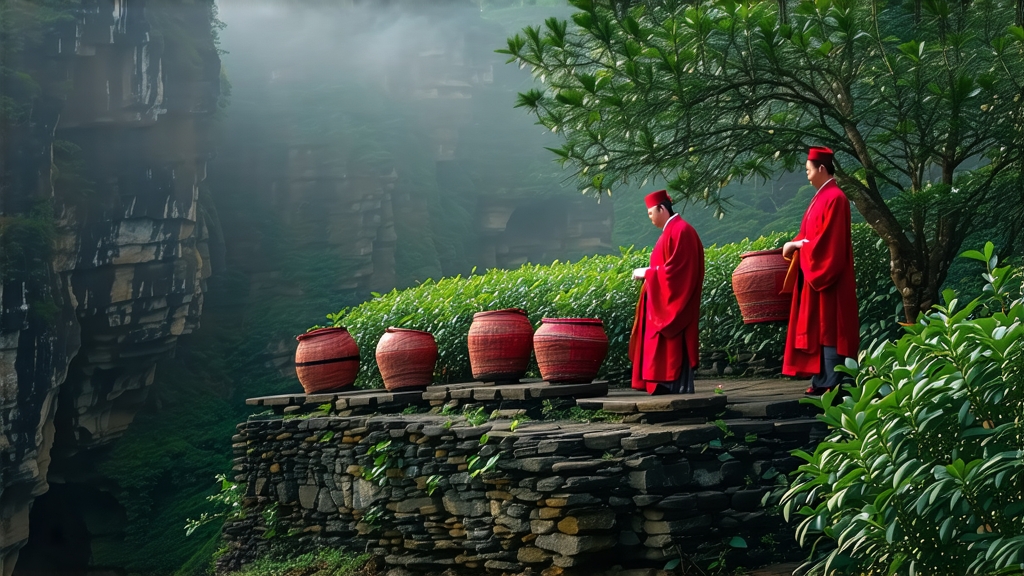
When Chinese tea lovers speak of “rock tea,” they are invoking the spirit of Wuyi Da Hong Pao, the scarlet-robed sovereign that grows on the sheer cliffs of northern Fujian. Legends say that a Ming-dynasty scholar, cured by this tea after falling ill on his way to the capital, wrapped the bushes in his own imperial-red robe to protect them; the name “Big Red Robe” has clung to the leaves ever since. Whether myth or memory, the story captures the reverence that has surrounded this oolong for more than three centuries, turning a handful of ancient shrubs into the most coveted tea in China.
Geology gives the first signature. The Wuyi range is a UNESCO World Heritage landscape of vertical sandstone gorges, mineral-rich runoff, and a micro-climate trapped by perpetual mist. In the narrow “Nine-Dragon Gorge,” daytime heat reflects off the cliffs while cool air drains from the peaks at night; the 15-degree swing forces the tea to thicken its cell walls, concentrating aromatic oils and soluble minerals. Locals call this terroir “yan yun”—rock rhyme—a tactile echo of wet stone that lingers in the throat long after the cup is empty.
Da Hong Pao is not a single cultivar but a stylistic family. The original “mother trees,” six ancient bushes still visible on Tianxin Rock, have not been harvested since 2006 when the government protected them. Today’s market offers three tiers: “pure pedigree” cuttings vegetatively propagated from those mothers (qidi), “rock tea” from authorized Wuyi scenic-area gardens (zhengyan), and “half-rock” or “riverbank” tea from adjacent counties. Within each tier, leaf material is further differentiated by cultivar—Beidou, Queshe, Yaoshi, and the peppery Qi Dan—each translating the cliff minerals through its own genetic accent.
Crafting Da Hong Pao is a two-week choreography of stress and rest. Picking occurs in late April when three half-open leaves form a soft, jade-green arc. The pluck is spread on bamboo trays to wither under the mountain wind; hourly turning bruises the edges just enough to start enzymatic oxidation without crushing the veins. At dusk the leaves are shaken in rattan drums, a motion that taunts the leaf edges into reddening while the centers stay green—the “green heart with red edge” hallmark of premium oolong. Overnight, the tea sleeps in hemp sacks, exhaling grassy aldehydes and drawing in fruity esters. At dawn the sack is opened; if the room smells of ripe apricot and wet slate, the tea is ready for heat.
Kill-green happens at 240 °C for three minutes in a cast-iron wok wide enough to hold a child’s bathtub. The master’s bare hands flip the leaves against the searing metal, stopping oxidation at roughly 40 %—the midpoint between green and black. Rolling follows while the leaf is still pliable: five minutes under mechanical pressure twists the tissue into the tight, dragonfly-wing strips that will later unfurl like miniature scrolls. After a brief rest, the tea enters the most Wuyi-specific stage—charcoal roasting. Using only local hardwood embers buried in ash, the tea is baked in bamboo baskets stacked three tiers high. Over eight hours the leaf temperature rises to 80 °C, then cools, then rises again; the cycle is repeated two to four times across as many weeks. Each roast drives out moisture, caramelizes residual sugars, and layers a whisper of smoke that will vanish after six months of aging, leaving behind the candied orchid and iron-note finish that collectors prize.
To brew Da Hong Pao like a Wuyi cliff monk, begin with spring water whose hardness is below 80 ppm; minerals amplify the rock rhyme, while hard water mutes it. Pre-heat a 120 ml Yixing teapot made from zhuni clay whose high iron content flatters the tea’s structure. Fill the pot one-third full with dry leaf—about 6 g. The first infusion is a three-second “awakening” rinse, discarded to open the leaf and rinse away roasting dust. Subsequent steeps start at five seconds, adding two seconds each round; a single load can yield twelve infusions, each revealing a different stratum of aroma. Early pours release roasted peach and narcissus; mid-infusions unveil raw cacao and graphite; the final cups taper into sweet talc and cooling cam